Tim Polzehl
Two Views, One Truth: Spectral and Self-Supervised Features Fusion for Robust Speech Deepfake Detection
Jul 27, 2025Abstract:Recent advances in synthetic speech have made audio deepfakes increasingly realistic, posing significant security risks. Existing detection methods that rely on a single modality, either raw waveform embeddings or spectral based features, are vulnerable to non spoof disturbances and often overfit to known forgery algorithms, resulting in poor generalization to unseen attacks. To address these shortcomings, we investigate hybrid fusion frameworks that integrate self supervised learning (SSL) based representations with handcrafted spectral descriptors (MFCC , LFCC, CQCC). By aligning and combining complementary information across modalities, these fusion approaches capture subtle artifacts that single feature approaches typically overlook. We explore several fusion strategies, including simple concatenation, cross attention, mutual cross attention, and a learnable gating mechanism, to optimally blend SSL features with fine grained spectral cues. We evaluate our approach on four challenging public benchmarks and report generalization performance. All fusion variants consistently outperform an SSL only baseline, with the cross attention strategy achieving the best generalization with a 38% relative reduction in equal error rate (EER). These results confirm that joint modeling of waveform and spectral views produces robust, domain agnostic representations for audio deepfake detection.
Private kNN-VC: Interpretable Anonymization of Converted Speech
May 23, 2025Abstract:Speaker anonymization seeks to conceal a speaker's identity while preserving the utility of their speech. The achieved privacy is commonly evaluated with a speaker recognition model trained on anonymized speech. Although this represents a strong attack, it is unclear which aspects of speech are exploited to identify the speakers. Our research sets out to unveil these aspects. It starts with kNN-VC, a powerful voice conversion model that performs poorly as an anonymization system, presumably because of prosody leakage. To test this hypothesis, we extend kNN-VC with two interpretable components that anonymize the duration and variation of phones. These components increase privacy significantly, proving that the studied prosodic factors encode speaker identity and are exploited by the privacy attack. Additionally, we show that changes in the target selection algorithm considerably influence the outcome of the privacy attack.
BiCrossMamba-ST: Speech Deepfake Detection with Bidirectional Mamba Spectro-Temporal Cross-Attention
May 20, 2025
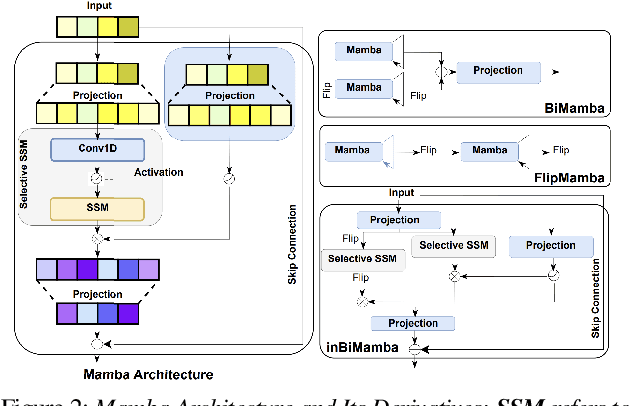
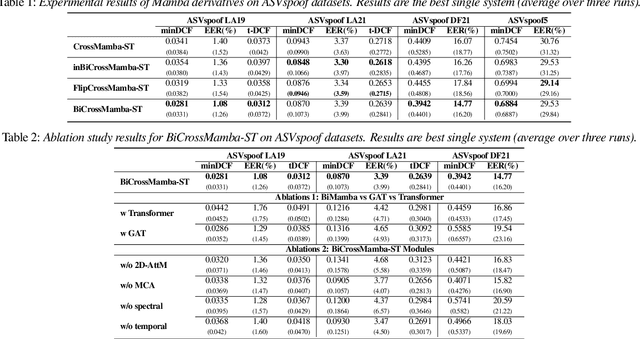

Abstract:We propose BiCrossMamba-ST, a robust framework for speech deepfake detection that leverages a dual-branch spectro-temporal architecture powered by bidirectional Mamba blocks and mutual cross-attention. By processing spectral sub-bands and temporal intervals separately and then integrating their representations, BiCrossMamba-ST effectively captures the subtle cues of synthetic speech. In addition, our proposed framework leverages a convolution-based 2D attention map to focus on specific spectro-temporal regions, enabling robust deepfake detection. Operating directly on raw features, BiCrossMamba-ST achieves significant performance improvements, a 67.74% and 26.3% relative gain over state-of-the-art AASIST on ASVSpoof LA21 and ASVSpoof DF21 benchmarks, respectively, and a 6.80% improvement over RawBMamba on ASVSpoof DF21. Code and models will be made publicly available.
Comprehensive Layer-wise Analysis of SSL Models for Audio Deepfake Detection
Feb 05, 2025



Abstract:This paper conducts a comprehensive layer-wise analysis of self-supervised learning (SSL) models for audio deepfake detection across diverse contexts, including multilingual datasets (English, Chinese, Spanish), partial, song, and scene-based deepfake scenarios. By systematically evaluating the contributions of different transformer layers, we uncover critical insights into model behavior and performance. Our findings reveal that lower layers consistently provide the most discriminative features, while higher layers capture less relevant information. Notably, all models achieve competitive equal error rate (EER) scores even when employing a reduced number of layers. This indicates that we can reduce computational costs and increase the inference speed of detecting deepfakes by utilizing only a few lower layers. This work enhances our understanding of SSL models in deepfake detection, offering valuable insights applicable across varied linguistic and contextual settings. Our trained models and code are publicly available: https://github.com/Yaselley/SSL_Layerwise_Deepfake.
Anonymising Elderly and Pathological Speech: Voice Conversion Using DDSP and Query-by-Example
Oct 20, 2024



Abstract:Speech anonymisation aims to protect speaker identity by changing personal identifiers in speech while retaining linguistic content. Current methods fail to retain prosody and unique speech patterns found in elderly and pathological speech domains, which is essential for remote health monitoring. To address this gap, we propose a voice conversion-based method (DDSP-QbE) using differentiable digital signal processing and query-by-example. The proposed method, trained with novel losses, aids in disentangling linguistic, prosodic, and domain representations, enabling the model to adapt to uncommon speech patterns. Objective and subjective evaluations show that DDSP-QbE significantly outperforms the voice conversion state-of-the-art concerning intelligibility, prosody, and domain preservation across diverse datasets, pathologies, and speakers while maintaining quality and speaker anonymity. Experts validate domain preservation by analysing twelve clinically pertinent domain attributes.
StarGAN-VC++: Towards Emotion Preserving Voice Conversion Using Deep Embeddings
Sep 14, 2023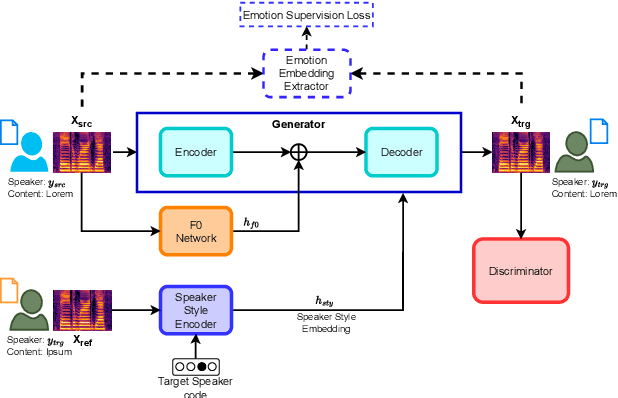

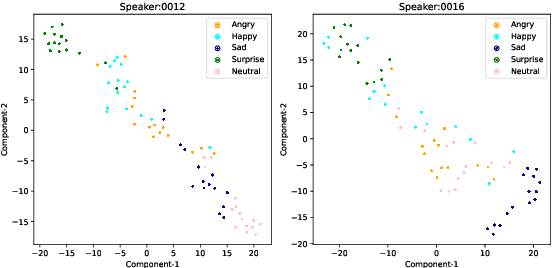
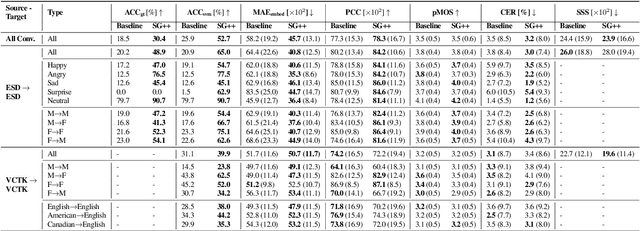
Abstract:Voice conversion (VC) transforms an utterance to sound like another person without changing the linguistic content. A recently proposed generative adversarial network-based VC method, StarGANv2-VC is very successful in generating natural-sounding conversions. However, the method fails to preserve the emotion of the source speaker in the converted samples. Emotion preservation is necessary for natural human-computer interaction. In this paper, we show that StarGANv2-VC fails to disentangle the speaker and emotion representations, pertinent to preserve emotion. Specifically, there is an emotion leakage from the reference audio used to capture the speaker embeddings while training. To counter the problem, we propose novel emotion-aware losses and an unsupervised method which exploits emotion supervision through latent emotion representations. The objective and subjective evaluations prove the efficacy of the proposed strategy over diverse datasets, emotions, gender, etc.
Emo-StarGAN: A Semi-Supervised Any-to-Many Non-Parallel Emotion-Preserving Voice Conversion
Sep 14, 2023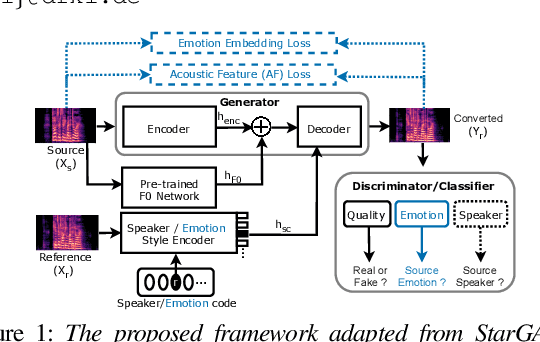
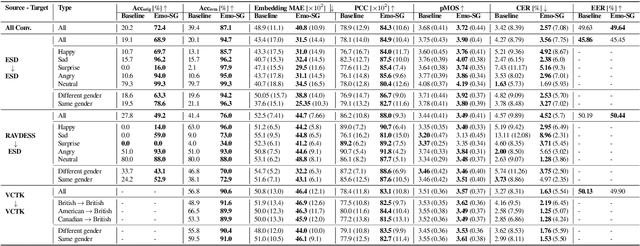


Abstract:Speech anonymisation prevents misuse of spoken data by removing any personal identifier while preserving at least linguistic content. However, emotion preservation is crucial for natural human-computer interaction. The well-known voice conversion technique StarGANv2-VC achieves anonymisation but fails to preserve emotion. This work presents an any-to-many semi-supervised StarGANv2-VC variant trained on partially emotion-labelled non-parallel data. We propose emotion-aware losses computed on the emotion embeddings and acoustic features correlated to emotion. Additionally, we use an emotion classifier to provide direct emotion supervision. Objective and subjective evaluations show that the proposed approach significantly improves emotion preservation over the vanilla StarGANv2-VC. This considerable improvement is seen over diverse datasets, emotions, target speakers, and inter-group conversions without compromising intelligibility and anonymisation.
Speaker adaptation for Wav2vec2 based dysarthric ASR
Apr 02, 2022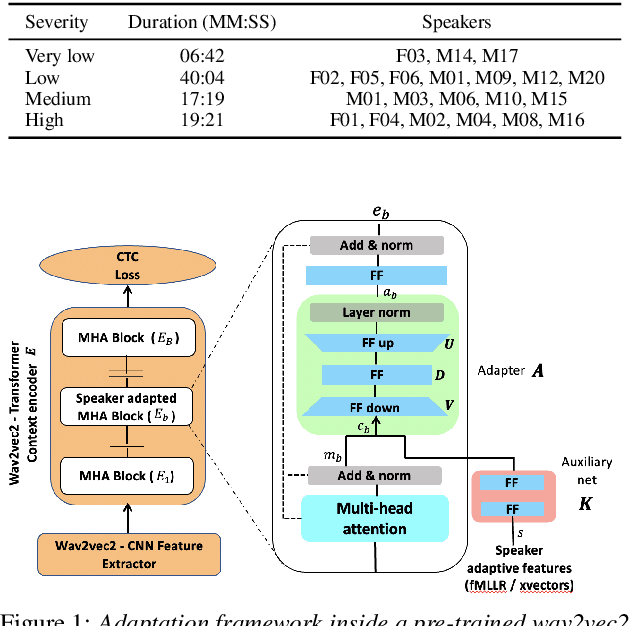
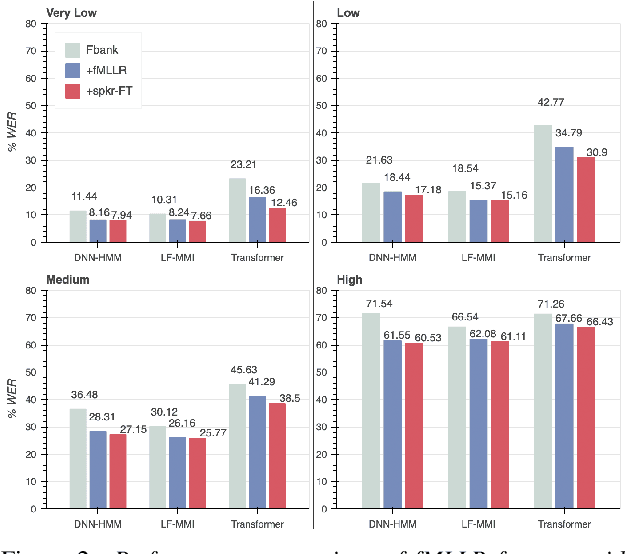
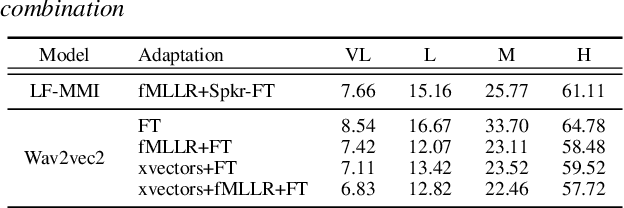
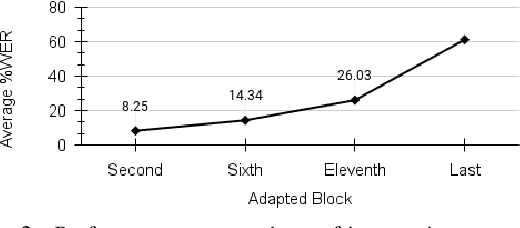
Abstract:Dysarthric speech recognition has posed major challenges due to lack of training data and heavy mismatch in speaker characteristics. Recent ASR systems have benefited from readily available pretrained models such as wav2vec2 to improve the recognition performance. Speaker adaptation using fMLLR and xvectors have provided major gains for dysarthric speech with very little adaptation data. However, integration of wav2vec2 with fMLLR features or xvectors during wav2vec2 finetuning is yet to be explored. In this work, we propose a simple adaptation network for fine-tuning wav2vec2 using fMLLR features. The adaptation network is also flexible to handle other speaker adaptive features such as xvectors. Experimental analysis show steady improvements using our proposed approach across all impairment severity levels and attains 57.72\% WER for high severity in UASpeech dataset. We also performed experiments on German dataset to substantiate the consistency of our proposed approach across diverse domains.
Does Summary Evaluation Survive Translation to Other Languages?
Sep 16, 2021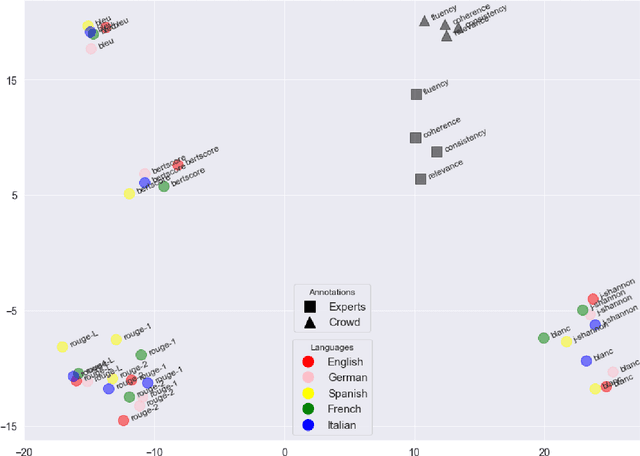
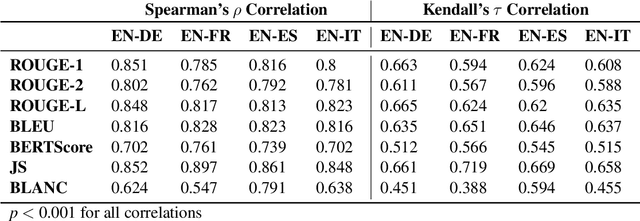
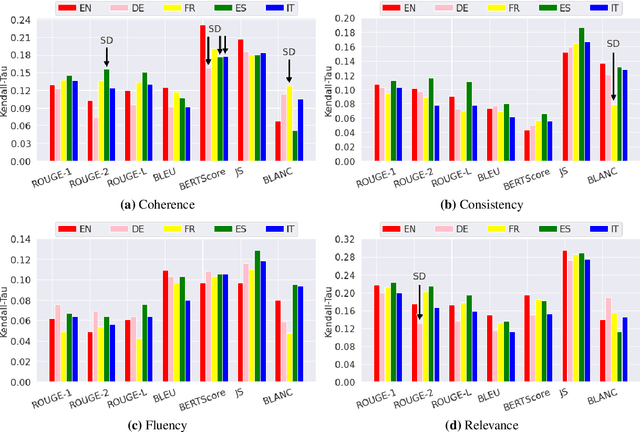
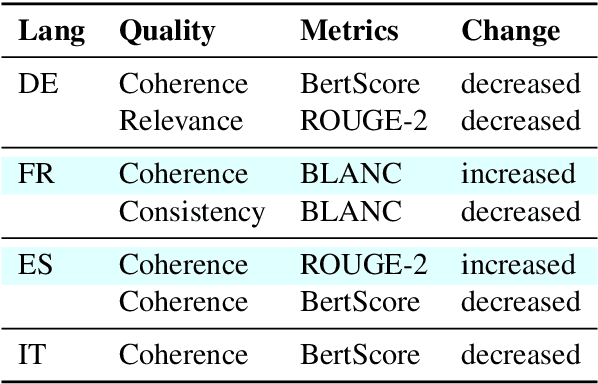
Abstract:The creation of a large summarization quality dataset is a considerable, expensive, time-consuming effort, requiring careful planning and setup. It includes producing human-written and machine-generated summaries and evaluation of the summaries by humans, preferably by linguistic experts, and by automatic evaluation tools. If such effort is made in one language, it would be beneficial to be able to use it in other languages. To investigate how much we can trust the translation of such dataset without repeating human annotations in another language, we translated an existing English summarization dataset, SummEval dataset, to four different languages and analyzed the scores from the automatic evaluation metrics in translated languages, as well as their correlation with human annotations in the source language. Our results reveal that although translation changes the absolute value of automatic scores, the scores keep the same rank order and approximately the same correlations with human annotations.
Towards Human-Free Automatic Quality Evaluation of German Summarization
May 13, 2021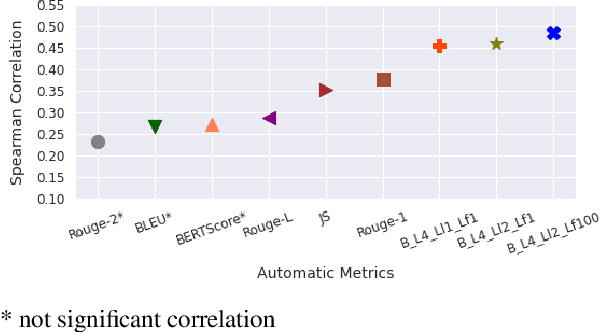

Abstract:Evaluating large summarization corpora using humans has proven to be expensive from both the organizational and the financial perspective. Therefore, many automatic evaluation metrics have been developed to measure the summarization quality in a fast and reproducible way. However, most of the metrics still rely on humans and need gold standard summaries generated by linguistic experts. Since BLANC does not require golden summaries and supposedly can use any underlying language model, we consider its application to the evaluation of summarization in German. This work demonstrates how to adjust the BLANC metric to a language other than English. We compare BLANC scores with the crowd and expert ratings, as well as with commonly used automatic metrics on a German summarization data set. Our results show that BLANC in German is especially good in evaluating informativeness.
 Add to Chrome
Add to Chrome Add to Firefox
Add to Firefox Add to Edge
Add to Edge